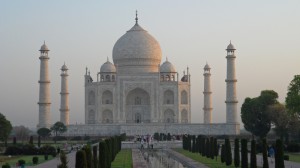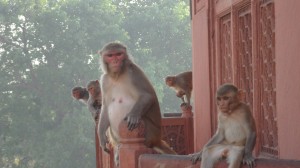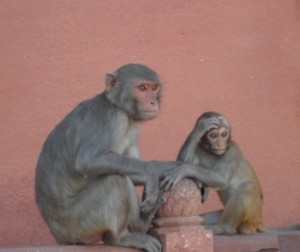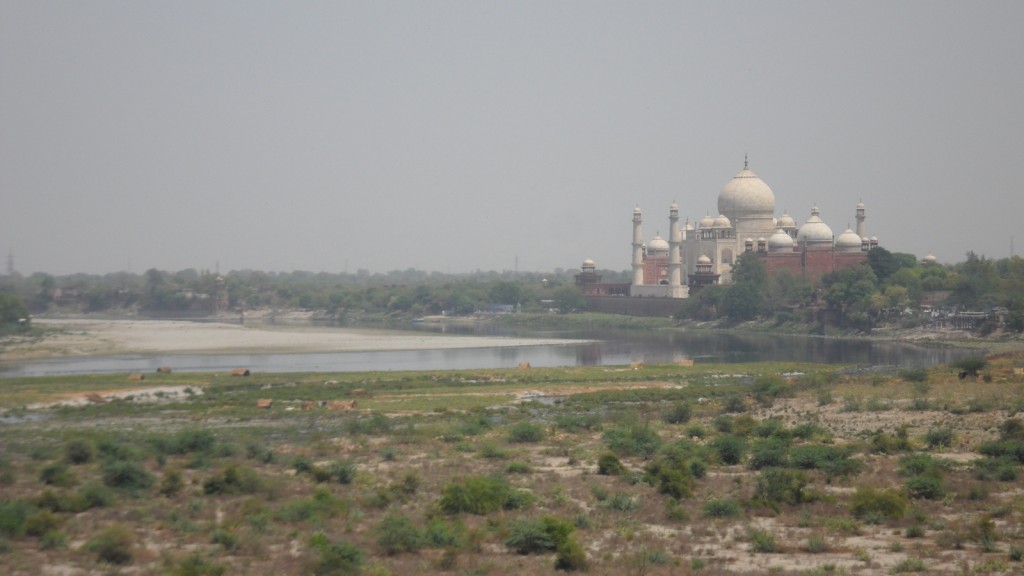April 24th is the most auspicious day to be married in India. Our driver tells us that 10,000 weddings will be happening on the day we depart from Jaipur, heading to Agra. Whether this is fact or fiction we are on our way to see the Taj Mahal, one of the world’s greatest treasures that exists because of married love (to house the tomb of a favorite wife who died giving birth to their 14th child, a daughter).
By now we’re used to the roads being in every stage of building or repair. Camels pull loads of bricks, wagons, cars and buses overflowing with people, packed in like produce. Along the way, our driver has planned a special stop for us to see a very ancient Durga/Devi temple.
Nearing our destination we pass a wedding party heading in the opposite direction. A crowd of well-dressed Indians gather and parade along the dirt road behind a machine with half a dozen megaphone speakers mounted on wheels, brightly painted and broadcasting music. The bride and groom travel in their own wagon, gilded with sparkling fabrics and pulled by colorfully decorated horses. Random stops give way to dances and clapping as a few trumpeters and drummers reinforce the celebratory sounds rising from the crowd. Women in a rainbow’s spectrum of saris carry clay pots on their heads and smiles bloom among the group more plentifully than spring flowers after the rain. We’ll be seeing many more of these boisterous weddings and their vestiges over the next few days.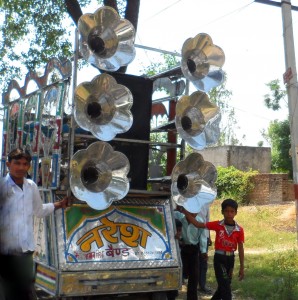
After visiting the roadside temple, we travel on for our tour of Fatehpur Sikri built in 1569 by Akbar the great, 23 miles west of Agra where the settlement eventually moved. A great thinker and lover of arts and literature, Akbar was one of the most unifying rulers of the Mughal Empire bringing economic prosperity and religious harmony to the region.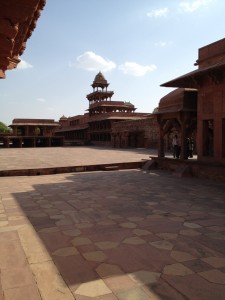
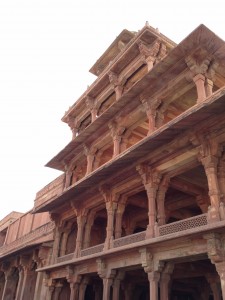
The sun beats down on the complex, tessellated stone work and architecture. We gaze around the courtyards and out at the surrounding now-dry landscape once flooded with water for the artificial lake and gardens built to cool Akbar’s palaces.
We finish our tour of Fatehpur Sikri and head to our palatial hotel (a big luxury) where we’re assured a view of the Taj Mahal that we’re to visit in the morning. We get unpacked and head out to a pool as dusk falls and strange bird calls fill the air. As we swim, stars fill the sky and bats swoop low over the water to catch the appetizers of their night’s meal. We must be up and out by 6:30 am to see the morning light bathe the white marble of one of the seven wonders of the world.
The next day we forgo breakfast to join the line of tourists and Indians anxious to view the tomb and monument (named for Mumtaz Mahal, wife of Shah Jahan) which took over 22 years, and the labor of 20,000 workers and 1,000 elephants to complete.
All this beauty exists, in part, because a woman died in childbirth. Imagine if there had been better OB/GYN services back then … but I’ll save that subject for the next blog about visiting the Indian hospitals where my sister and I were born.
When I was a child I heard that as my parents toured the Taj Mahal (with their three little girls) a Maharaja and his grand entourage swept passed our family.
I also learned its history, how many of the semi-precious stones placed with care in the white marble were stolen and how it fell into disrepair before being restored. What I didn’t hear was how the ruler who envisioned this tomb and monument was eventually deposed and imprisoned within a stone’s throw of his precious dream, attended to by the daughter who survived after her mother’s death. I also wasn’t aware of the mosques built on either side one for use, one for symmetry. As I took in the majesty of these buildings and grounds I was joined by the current residents of the Taj Mahal (monkeys) who had gotten through their spring pregnancies and deliveries just fine. They filed out along the red railings and joined the rest of us as we looked around in wonder.
There are dogs playing down on the lawns next to the river, which is more dry bed than water. The red-butted monkeys, with their babies hanging on or trailing behind, move out among the people and the morning begins to heat up as the crowds continue to grow. We take a few more pictures, finish breathing in the atmosphere of the most visited tourist site in India and head over to see the Agra Fort where the ruler spent his final years.The Agra fort has the white marble and many of the same artisan touches that grace the Taj Mahal … hard to imagine as a prison. I’ll post the view from its royal chambers and hope you enjoyed the visit.

